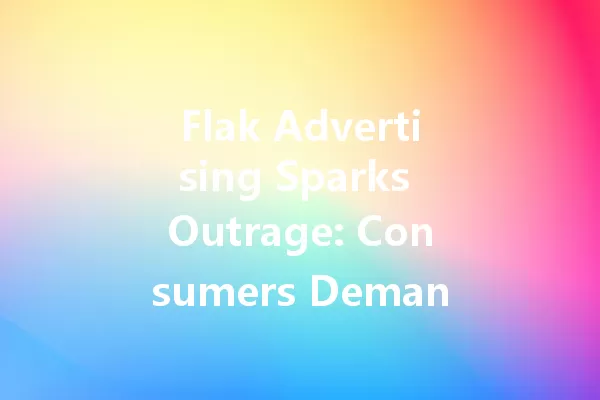
Flak advertising has become a hot topic these days, and it’s not hard to see why. In an age where social media dominates how we consume content, the line between genuine marketing and misleading tactics is becoming blurred. Brands often try to stand out by using flashy graphics and persuasive language, but many consumers are now questioning the authenticity of these marketing efforts. With increasing access to information, people are more informed than ever, and they’re calling out deceptive practices.
What is Flak Advertising?
Flak advertising refers to promotional techniques that mix factual information with exaggerated claims or emotional appeals, making it difficult for consumers to discern the truth. Companies employ these methods to attract attention quickly, but the backlash can be severe when customers feel misled. So, what exactly makes up flak advertising? Here are some typical characteristics:
Consumer Backlash
As consumers become more critical, the impacts of flak advertising are becoming glaringly obvious. People are demanding more credibility and transparency from brands. Rather than relinquishing their purchasing power, they are using social media platforms to voice their grievances. This consumer activism is reshaping how brands approach advertising. Businesses that fail to recognize this shift risk losing both their reputation and their customer base. In fact, studies show that:
This rise in expectation has also led to brands reassessing their marketing strategies to ensure they are being forthright and honest.
在所有文章50%位置插入在所有文章50%位置插入在所有文章50%位置插入在所有文章50%位置插入在所有文章50%位置插入在所有文章50%位置插入在所有文章50%位置插入在所有文章50%位置插入在所有文章50%位置插入在所有文章50%位置插入在文章中间添加自定义内容在文章中间添加自定义内容在文章中间添加自定义内容在文章中间添加自定义内容在文章中间添加自定义内容在文章中间添加自定义内容在文章中间添加自定义内容在文章中间添加自定义内容在文章中间添加自定义内容在文章中间添加自定义内容在文章中间添加自定义内容在文章中间添加自定义内容在文章中间添加自定义内容在文章中间添加自定义内容
The Demand for Transparency
With the growing dissatisfaction toward flak advertising, brands are now aware that they must change their tactics. Transparency is now essential in building trust with consumers. Many companies are adjusting their marketing to focus more on truthfulness and clarity. This can involve:
By implementing these practices, brands can not only avoid backlash but also foster a stronger relationship with their audience.
Implications for Marketing Strategies
The shift away from flak advertising is more than just a trend; it’s a fundamental change in how businesses operate. Many agencies and marketing professionals are now prioritizing ethical practices in advertising. Companies are beginning to realize the importance of an honest approach, and here are a few implications of this shift:

The Bottom Line
The conversation surrounding flak advertising and the demand for truth in marketing is reshaping the advertising landscape. It’s clear that consumers are more empowered than ever, and they expect brands to meet their new standards. As this evolution continues, brands must adapt or risk being left behind in a marketplace that no longer tolerates inauthenticity.
Social media has fundamentally transformed the landscape of consumer behavior, empowering individuals to express their opinions and share experiences like never before. When it comes to flak advertising, this platform allows consumers to call out brands that use misleading tactics instantly. A single tweet or Instagram post can spread rapidly, reaching thousands or even millions of people within hours. This kind of visibility turns the spotlight on deceptive advertising practices, creating a community of informed consumers who hold brands accountable for their claims. As people communicate their frustrations online, the collective voice becomes a powerful force that companies cannot ignore.
Moreover, the consequences of not addressing consumer concerns can be severe for brands. With social media acting as a magnifying glass over flak advertising, negative feedback can lead to a damaged reputation almost overnight. Companies that previously relied on flashy graphics and persuasive language must now rethink their strategies, recognizing that transparency and honesty are essential in building and maintaining consumer trust. The pressure to adapt is not just a passing trend; it’s a response to the heightened expectations of consumers who demand authenticity in marketing. Consequently, brands that ignore these changes risk losing their audience to competitors who embrace a more straightforward and truthful approach.
What is Flak Advertising?
Flak advertising involves promotional practices that blur the line between genuine information and misleading claims. It often features exaggerated marketing messages designed to capture attention quickly but may lead to consumer distrust.
Why are consumers concerned about Flak Advertising?
Consumers are increasingly concerned about flak advertising because it can lead to deception and disappointment. As people become more informed via social media and online reviews, they expect greater authenticity and transparency from brands.
How can brands avoid Flak Advertising?
Brands can avoid flak advertising by focusing on clear communication, providing honest information, and backing claims with solid evidence. Building trust through real customer testimonials and avoiding exaggerated statements also helps.
How has social media influenced consumer reactions to Flak Advertising?
Social media has empowered consumers to voice their opinions and share their experiences, making it easier for them to call out flak advertising. This increased visibility can amplify consumer outrage and pressure brands to adopt more transparent practices.
What are the implications of demanding truth in marketing?
Demanding truth in marketing can lead to a shift toward more ethical advertising practices, improved consumer-brand relationships, and ultimately a stronger reputation for brands committed to honesty. This demand for transparency is likely to shape the future of marketing strategies.
在文章结尾添加自定义内容在文章结尾添加自定义内容在文章结尾添加自定义内容在文章结尾添加自定义内容在文章结尾添加自定义内容在文章结尾添加自定义内容在文章结尾添加自定义内容在文章结尾添加自定义内容在文章结尾添加自定义内容在文章结尾添加自定义内容在文章结尾添加自定义内容在文章结尾添加自定义内容在所有文章结尾添加内容在所有文章结尾添加内容在所有文章结尾添加内容在所有文章结尾添加内容在所有文章结尾添加内容在所有文章结尾添加内容在所有文章结尾添加内容在所有文章结尾添加内容在所有文章结尾添加内容